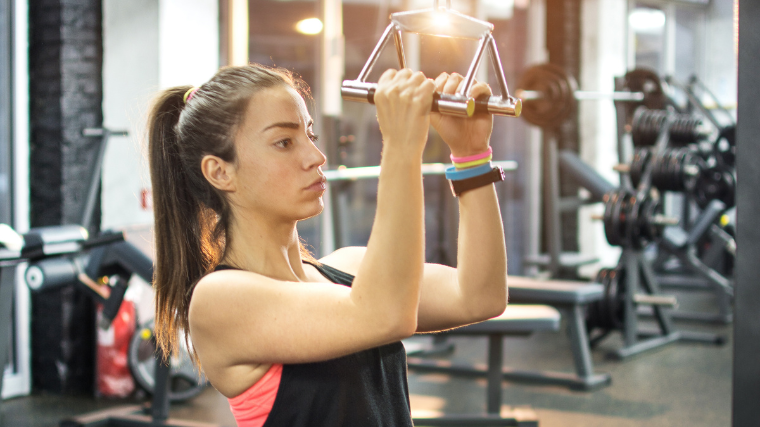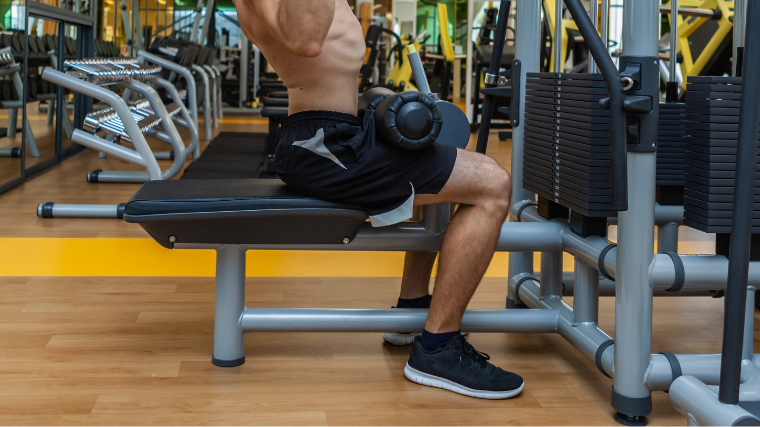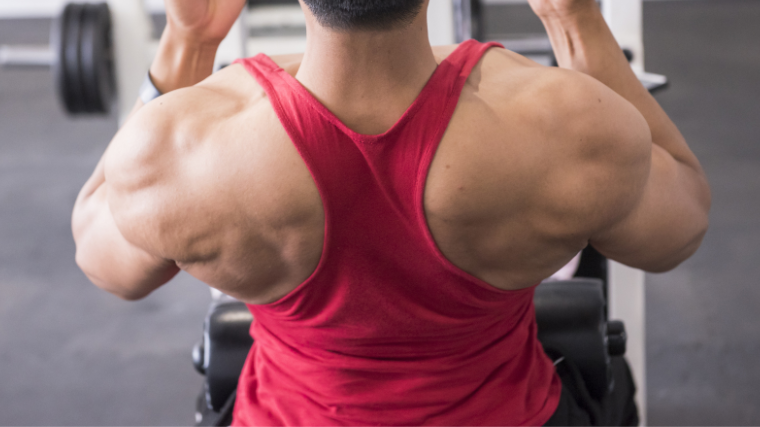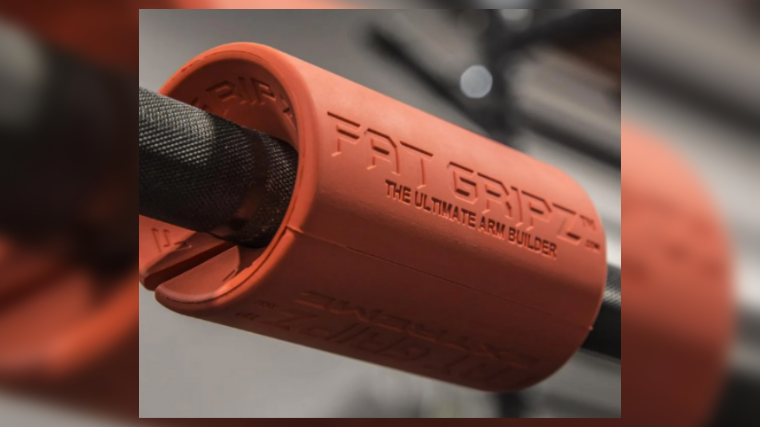Pulldowns, pull-ups, row horizontally, row while standing upright, row while inverted. Your back is one of the most versatile muscle groups you have…but that doesn’t necessarily make optimal lat training any simpler.
With so many options to choose from, figuring out which pulling movement is just right for you can be a real head-scratcher. Nevermind knowing how the angle of your arm affects muscle recruitment, strength potential, and all that good stuff.

You don’t have to go to bat for the inclusion of the lat pulldown in most workout routines. If you want a pair of wide lats that can help you soar (and maybe stretch your t-shirt while you’re at it), the close-grip lat pulldown should be your bread and butter.
- How to Do the Close-Grip Pulldown
- Close-Grip Pulldown Sets and Reps
- Common Close-Grip Pulldown Mistakes
- Close-Grip Pulldown Variations
- Close-Grip Pulldown Alternatives
- Muscles Worked by the Close-Grip Pulldown
- Benefits of the Close-Grip Pulldown
- Who Should Do the Close-Grip Pulldown
- Frequently Asked Questions
How to Do the Close-Grip Pulldown
The lat pulldown isn’t a particularly complicated movement to begin with, but you do need access to the station itself — or some form of adjustable cable tree.
To get the most value from the close-grip pulldown, you’ll want to perform it in a dedicated lat pulldown station with the neutral-grip handle attachment.
Step 1 — Set the Seat

First and foremost, make sure the thigh guards of the lat pulldown station are adjusted to the proper height. When you sit down into the station, the thigh pads should press firmly, but not painfully, against your legs. You should be able to scoot your shin underneath and plant your entire foot on the floor.
Coach’s Tip: Make sure to adjust the station to your comfort level before beginning the movement.
Step 2 — Grip and Brace

Once you’ve got the thigh pads where you want them, stand up. Grab the handles of the parallel-grip cable attachment while standing and then sit down into the seat, bringing the handles with you.
Once seated, contract your abs to brace your trunk. Your arms should be roughly in line with your head and you should have a small arch in your lower back.
Coach’s Tip: Avoid dramatically arching your back while you perform the close-grip pulldown.
Step 3 — Pull and Tuck

Once you’re set up and braced, take a deep breath and then pull the handle down to your upper chest. Tuck your elbows in tight to your sides, pulling until your forearms gently contact your trunk.
Coach’s Tip: Think about “putting your elbows in your pockets” to better engage your back.
Close-Grip Pulldown Sets and Reps
The close-grip pulldown is a meat-and-potatoes back movement that you can use for a variety of different purposes. As such, how you program it will determine what results you stand to gain.
- As a Beginner: Try 3 sets of 10 reps with a moderate weight, focusing on your form.
- For Back Strength: Do 4 to 5 sets of 6 to 8 reps with a heavy weight.
- For Muscle Growth: Get in 3 to 5 sets of 8 to 12 reps with a moderate weight and good form.
Common Close-Grip Pulldown Mistakes
It may not be as intricate as a back squat or power clean, but you should still pay dutiful attention to your technique. Mastering the close-grip pulldown can help you squeeze out every ounce of back gains from it.
Using Momentum
The secure fixture of the thigh pad can make it all too tempting to cheat your form on lat pulldowns of any kind, since it gives you something to leverage yourself against.
However, using momentum to help “swing” the handle down to your body isn’t making you any stronger. It’s an exercise in futility. Loose posture and extra momentum remove some of the mechanical tension that proper form places on your back muscles in the first place, so stay tight.
Pulling Too Low
When performing the close-grip pulldown, there is such a thing as too much of a good thing. Some gymgoers may be tempted to continue bringing the handle down after their upper arms are already tucked into their sides.
Not only does this do nothing for your back muscles, but it may also in some cases add unwanted stress to your wrists, elbows, or shoulders.
Once your arms tuck into your sides, you’ve fully engaged your lats and have nothing else to gain by pulling deeper.
Using Your Arms
Your biceps and brachialis muscles assist your upper back during the close-grip pulldown, but they shouldn’t steal the show.
Try to mentally detach yourself from the idea that you need to use your arms to pull the weight. Instead, think about “leading with your shoulder” as you begin each rep. Your shoulders should depress as you pull and elevate as you raise the handle back up to the starting position.
[Read More: Best Biceps Exercises for a Muscle-Building Workout]
If all you feel during the close-grip pulldown is a biceps pump, your form is likely off.
Close-Grip Pulldown Variations
There aren’t too many ways to fiddle with the close-grip pulldown. After all, if it isn’t broke why fix it? However, you can make some small adjustments to your setup or execution for different purposes.
Single-Arm Close-Grip Pulldown
If you have a muscle or strength imbalance in your back, are working around an injury, or just want to really dial in on your form, you can perform the close-grip pulldown with one arm at a time.
Doing so will allow you to practice pulling and contracting one of your lats independently of the other. You can swap out the parallel handle attachment for a single-grip attachment, or just grab the thing with one arm and pull normally.
Fat Gripz Close-Grip Pulldown
If you have a pair of Fat Gripz, you can turn the close-grip pulldown into a great grip strengthening exercise in addition to being a phenomenal back-builder.

Fat Gripz are a weight room accessory that you wrap around the handle of a free weight. A thicker handle is harder to grip, requiring you to engage your forearms and crushing power while usually limiting the weight you can use as well.
If you don’t have access to a pair of Fat Gripz, you can wrap two small towels around each of the parallel bars of the pulldown attachment.
Close-Grip Pulldown Alternatives
Love the close-grip pulldown but don’t have access to the station? Whether there’s an inconsiderate gymgoer hogging the machine or you can’t make it to the gym at all, you need viable alternatives.
Dumbbell Seal Row
You can mimic almost the exact same technique with a pair of dumbbells by performing an exercise called the seal row.
By bracing your torso on an inclined weight bench, you can essentially invert the movement. The seal row works all of the same muscles, takes a bit more setup and stability, and doesn’t provide the consistent muscular tension of the cable station.
Neutral-Grip Pull-Up
If you prefer to work with just your bodyweight, you can replicate the close-grip pulldown as long as you have a set of parallel bars to hang onto.
A neutral, hands-parallel pull-up may be challenging if you don’t do a lot of bodyweight movements — even if you can use heavy weights on the pulldown station. However, it does provide an awesome stability challenge and doesn’t require a specialty piece of gym equipment.
Muscles Worked by the Close-Grip Pulldown
The close-grip pulldown is a lat exercise through and through. However, there are other muscles in play as well. Plus, you should know just how the posture of your arm affects how you train your back.
Lats
Your lattisimus dorsi, or lats, are the prime mover during the close-grip pulldown. They function to retract and depress your shoulder during most upper-body pulling movements.
However, the close-grip hand position affects just how much overall tension is applied right on your lats. Generally speaking, a tucked upper arm will engage your lats more than the various other muscles of your upper back by putting the lat fibers in vertical alignment with the direction you’re pulling.
Traps
Along with your lats, your trapezius muscles also function to pull your shoulder blades down and back during the close-grip lat pulldown. However, they won’t steal the show if you have good technique.
You should emphasize squeezing your shoulder blades together at the end of each rep if you want to really engage your middle traps.
Biceps & Brachialis
Despite not being an arm exercise, you’ll find that the close-grip pulldown involves your biceps and brachialis muscles to some degree, since both tissues serve to bend the elbow.

However, your arms should not dominate the pulling motion. If they do, you may be using poor form or have a weak mind-muscle connection with your lats.
Benefits of the Close-Grip Pulldown
It builds your back, sure, but the close-grip pulldown has a few other things going for it that make it worth inclusion in your workout routine.
Builds Your Entire Back
As a compound, multi-joint pulling movement, the close-grip pulldown is a phenomenal all-in-one option for back day.
It’s a lat-centric exercise above all, but you’ll also get a degree of stimulation on your traps and the other assorted smaller tissues in your upper back.
Easy to Learn
There’s something to be said for simplicity. While there are small technical elements to any pulldown that separate newbies from expert lifters, the close-grip pulldown is easy to learn and thus very suitable for beginners.
Limited Lower Back Stress
Some free-weight pulling movements can tax your posterior chain to a great degree. This is great if a full-body challenge is what you’re after, but not everyone wants to tax their lumbar spine if they’re just trying to broaden their back.
[Read More: Best Lower Back Exercises for Strength and Reduced Pain]
The close-grip pulldown is a spine-stress-free method of targeting your lats, making it a great option if your back is a bit tender or beat up.
Who Should Do the Close-Grip Pulldown
It’s not for everyone, but it kind of is. As far as back exercises go, you can’t really go wrong with the close-grip pulldown.
Beginners
First-time gymgoers would do well to include the close-grip pulldown. It trains most of your back without demanding a large amount of external stability. Moreover, it’s straightforward to learn, and doesn’t require you to learn a particularly intricate movement pattern to get started.
Bodybuilders
If you’re after muscle growth, you should seek exercises that check many of the boxes that go into creating hypertrophy — mechanical tension, metabolic stress, and muscle damage.
The close-grip pulldown hits all three to varying degrees. The cable provides consistent tension to your back, you can lift quite heavy without risking injury or accident, and you can program it in a variety of different ways.
Big Pulls for Big Lats
You can train your back in a wide variety of different ways. But if you want wide lats, you need to dial in your workouts and find exercises that work.
The close-grip lat pulldown is a staple, time-tested back builder. It’s not muscle magic, but it’ll give results back to you if you put effort into it. Sub it into your next back day and see for yourself.
FAQs
All set up in the pulldown station and still stricken with doubt? Don’t worry; your questions have answers.
Can I use momentum on the lat pulldown?
Yes, there’s technically no harm in a small amount of “body English” while you lift weights. It can help you pump out a few extra reps at the end of your set, but it shouldn’t be something you rely on from start to finish.
Is the close-grip pulldown good for the upper back?
Yes, you will get a degree of stimulation on the other tissues in your back, though not as much as the exercise will hammer your lats. If you’re looking for more of a trap, rear delt, or shoulder girdle movement, grab a different handle and perform a standard or wide-grip pulldown instead.
Featured Image: pnarongkul / Shutterstock